Investigate the Spatiotemporal Evolution of Drought and Its Interaction with Atmospheric Circulation in the Yellow River Middle Basin
Abstract
:1. Introduction
2. Materials and Methods
2.1. Study Area and Data Sources
2.2. Calculation of Drought Index
2.3. Methods for Identifying Drought Characteristics
2.4. Drought Trends and Mutation Testing Methods
2.5. Drought Interaction with Atmospheric Circulation
3. Results
3.1. Time Variation Patterns and Trends of SPEI Changes
3.2. The Spatial Pattern of Drought Characteristics
3.3. Effects of Atmospheric Circulation on Drought
4. Discussion
4.1. The Variations and Trends of Drought
4.2. Non-Stationary Input Variables of the Drought Index
4.3. Atmospheric Circulation on Drought
5. Conclusions
Author Contributions
Funding
Data Availability Statement
Conflicts of Interest
References
- Yao, N.; Li, Y.; Lei, T.; Peng, L. Drought evolution, severity and trends in mainland China over 1961–2013. Sci. Total Environ. 2018, 616, 73–89. [Google Scholar] [CrossRef] [PubMed]
- Qiu, J.; Shen, Z.; Xie, H. Drought impacts on hydrology and water quality under climate change. Sci. Total Environ. 2023, 858, 159854. [Google Scholar] [CrossRef] [PubMed]
- Band, S.S.; Karami, H.; Jeong, Y.-W.; Moslemzadeh, M.; Farzin, S.; Chau, K.-W.; Bateni, S.M.; Mosavi, A. Evaluation of Time Series Models in Simulating Different Monthly Scales of Drought Index for Improving Their Forecast Accuracy. Front. Earth Sci. 2022, 10, 839527. [Google Scholar] [CrossRef]
- Bruins, H.J.; Berliner, P.R. Bioclimatic aridity, climatic variability, drought and desertification: Definitions and management options. In The Arid Frontier; Springer: Dordrecht, The Netherlands, 1998; pp. 97–116. [Google Scholar]
- Pausas, J.G. Changes in fire and climate in the eastern Iberian Peninsula (Mediterranean basin). Clim. Chang. 2004, 63, 337–350. [Google Scholar] [CrossRef]
- Farzin, S.; Anaraki, M.V.; Naeimi, M.; Zandifar, S. Prediction of groundwater table and drought analysis; a new hybridization strategy based on bi-directional long short-term model and the Harris hawk optimization algorithm. J. Water Clim. Chang. 2022, 13, 2233–2254. [Google Scholar] [CrossRef]
- Chen, J.; Wilson, C.; Tapley, B.; Yang, Z.; Niu, G.-Y. 2005 drought event in the Amazon River basin as measured by GRACE and estimated by climate models. J. Geophys. Res. Solid Earth 2009, 114, B05404. [Google Scholar] [CrossRef]
- Robeson, S.M. Revisiting the recent California drought as an extreme value. Geophys. Res. Lett. 2015, 42, 6771–6779. [Google Scholar] [CrossRef]
- Carse, A. An Infrastructural Event: Making Sense of Panama’s Drought. Water Altern. 2017, 10, 888–909. [Google Scholar]
- Bang, N.-K.; Nam, W.-H.; Hong, E.-M.; Michael, J.H.; Mark, D.S. Assessment of the meteorological characteristics and statistical drought frequency for the extreme 2017 spring drought event across South Korea. J. Korean Soc. Agric. Eng. 2018, 60, 37–48. [Google Scholar]
- Piao, S.; Ciais, P.; Huang, Y.; Shen, Z.; Peng, S.; Li, J.; Zhou, L.; Liu, H.; Ma, Y.; Ding, Y.; et al. The impacts of climate change on water resources and agriculture in China. Nature 2010, 467, 43–51. [Google Scholar] [CrossRef]
- Zhao, R.; Wang, H.; Hu, S.; Zhan, C.; Guo, J. Joint probability of drought encounter among three major grain production zones of China under nonstationary climate. J. Hydrol. 2021, 603, 126995. [Google Scholar] [CrossRef]
- Li, X.; Ye, X. Spatiotemporal characteristics of dry-wet abrupt transition based on precipitation in Poyang Lake basin, China. Water 2015, 7, 1943–1958. [Google Scholar] [CrossRef]
- Tao, J.; Qiao, W.; Li, H.; Qu, X.; Gan, R. Spatial and temporal evolution characteristics and causes of drought and flood in the Henan section of the Yellow River. Nat. Hazards 2022, 113, 997–1016. [Google Scholar] [CrossRef]
- Li, X.; Zhang, K.; Gu, P.; Feng, H.; Yin, Y.; Chen, W.; Cheng, B. Changes in precipitation extremes in the Yangtze River Basin during 1960–2019 and the association with global warming, ENSO, and local effects. Sci. Total Environ. 2021, 760, 144244. [Google Scholar] [CrossRef] [PubMed]
- Palmer, W.C. Meteorological Drought; US Department of Commerce, Weather Bureau: Washington, DC, USA, 1965; Volume 30.
- McKee, T.B.; Doesken, N.J.; Kleist, J. The relationship of drought frequency and duration to time scales. In Proceedings of the 8th Conference on Applied Climatology, Anaheim, CA, USA, 17–22 January 1993; pp. 179–183. [Google Scholar]
- Tsakiris, G.; Pangalou, D.; Vangelis, H. Regional drought assessment based on the Reconnaissance Drought Index (RDI). Water Resour. Manag. 2007, 21, 821–833. [Google Scholar] [CrossRef]
- Vicente-Serrano, S.M.; Beguería, S.; López-Moreno, J.I. A multiscalar drought index sensitive to global warming: The standardized precipitation evapotranspiration index. J. Clim. 2010, 23, 1696–1718. [Google Scholar] [CrossRef]
- Ali, Z.; Hussain, I.; Faisal, M.; Nazir, H.M.; Moemen, M.A.-e.; Hussain, T.; Shamsuddin, S. A novel multi-scalar drought index for monitoring drought: The standardized precipitation temperature index. Water Resour. Manag. 2017, 31, 4957–4969. [Google Scholar] [CrossRef]
- Shah, D.; Mishra, V. Integrated Drought Index (IDI) for drought monitoring and assessment in India. Water Resour. Res. 2020, 56, e2019WR026284. [Google Scholar] [CrossRef]
- He, L.; Tong, L.; Zhou, Z.; Gao, T.; Ding, Y.; Ding, Y.; Zhao, Y.; Fan, W. A Drought Index: The Standardized Precipitation Evapotranspiration Irrigation Index. Water 2022, 14, 2133. [Google Scholar] [CrossRef]
- Zhang, B.; Long, B.; Wu, Z.; Wang, Z. An evaluation of the performance and the contribution of different modified water demand estimates in drought modeling over water-stressed regions. Land Degrad. Dev. 2017, 28, 1134–1151. [Google Scholar] [CrossRef]
- López-Moreno, J.I.; Vicente-Serrano, S.M.; Zabalza, J.; Beguería, S.; Lorenzo-Lacruz, J.; Azorin-Molina, C.; Morán-Tejeda, E. Hydrological response to climate variability at different time scales: A study in the Ebro basin. J. Hydrol. 2013, 477, 175–188. [Google Scholar] [CrossRef]
- Yang, Y.; Wang, Y.; Kang, L. Analysis of Drought Types and Circulation Characteristics in the Mid Summer of the Yellow River. Yellow River 2004, 26, 37–39. (In Chinese) [Google Scholar]
- Wang, J.; Liu, H.; Kang, l.; Wang, Y. Analysis on the Changes of Drought in the Middle Reaches of Yellow River. J. Arid. Land Resour. Environ. 2006, 20, 109–113. (In Chinese) [Google Scholar]
- Liu, Y.; Wang, G.; Gu, Y.; Zhang, J.; Liu, J.; Jin, J.; Liu, J. Drought trend estimation based on improved standard precipitation index for the middle reaches of Yellow River. J. Arid Land Resour. Environ. 2013, 27, 75–80. (In Chinese) [Google Scholar]
- Zhang, B.; Wu, P.; Zhao, X.; Wang, Y.; Wang, J.; Shi, Y. Drought variation trends in different subregions of the Chinese Loess Plateau over the past four decades. Agric. Water Manag. 2012, 115, 167–177. [Google Scholar] [CrossRef]
- Huang, S.; Chang, J.; Leng, G.; Huang, Q. Integrated index for drought assessment based on variable fuzzy set theory: A case study in the Yellow River basin, China. J. Hydrol. 2015, 527, 608–618. [Google Scholar] [CrossRef]
- Chen, Y.; Zhou, R.; Wu, H. Features of the Western Pacific Subtropical High during the Warm and Cool Periods of Nino 1+ 2 Area and Its influence on the East Asian Monsoon. Chin. J. Atmos. Sci. Chin. Ed. 2002, 26, 386–392. [Google Scholar]
- Lee, H.; Zhang, D. Relationship between NAO and drought disasters in northwestern China in the last millennium. J. Arid Environ. 2011, 75, 1114–1120. [Google Scholar] [CrossRef]
- Yuan, Z.; Qin, J.; Li, S.; Huang, S.; Mbululo, Y. Impact of spring AAO on summertime precipitation in the North China Part: Observational analysis. Asia-Pac. J. Atmos. Sci. 2021, 57, 1–16. [Google Scholar] [CrossRef]
- Deng, S.; Cheng, L.; Yang, K.; Chen, Y.; Gao, Y.; Yang, N.; Li, M. A multi-scalar evaluation of differential impacts of canonical ENSO and ENSO Modoki on drought in China. Int. J. Climatol. 2019, 39, 1985–2004. [Google Scholar] [CrossRef]
- Guan, M. Causes Analysis of Serious Drought Event in 2004. J. Meteorol. Res. Appl. 2007, 28, 60–63. (In Chinese) [Google Scholar]
- Helsel, D.R.; Hirsch, R.M. Statistical Methods in Water Resources; Elsevier: Amsterdam, The Netherlands, 1992; Volume 49. [Google Scholar]
- Allen, R.G.; Pereira, L.S.; Raes, D.; Smith, M. Crop Evapotranspiration-Guidelines for Computing Crop Water Requirements; FAO Irrigation and Drainage Paper 56; FAO: Rome, Italy, 1998; Volume 300, p. D05109. [Google Scholar]
- Yevjevich, V.M. Objective Approach to Definitions and Investigations of Continental Hydrologic Droughts; Colorado State University Libraries: Fort Collins, CO, USA, 1967. [Google Scholar]
- Montaseri, M.; Amirataee, B. Comprehensive stochastic assessment of meteorological drought indices. Int. J. Climatol. 2017, 37, 998–1013. [Google Scholar] [CrossRef]
- Pettitt, A.N. A non-parametric approach to the change-point problem. J. R. Stat. Soc. Ser. C Appl. Stat. 1979, 28, 126–135. [Google Scholar] [CrossRef]
- Liang, X.; Lettenmaier, D.P.; Wood, E.F.; Burges, S.J. A Simple Hydrologically Based Model of Land-Surface Water And Energy Fluxes For General-Circulation Models. J. Geophys. Res.-Atmos. 1994, 99, 14415–14428. [Google Scholar] [CrossRef]
- Masanta, S.K.; Srinivas, V. Proposal and evaluation of nonstationary versions of SPEI and SDDI based on climate covariates for regional drought analysis. J. Hydrol. 2022, 610, 127808. [Google Scholar] [CrossRef]
- Zhu, Z.; Lu, L.; Yao, X.; Zhang, W.; Liu, W. AR6 Climate Change 2021: The Physical Science Basis; IPCC: Geneva, Switzerland, 2021. [Google Scholar]
- Milly, P.C.; Betancourt, J.; Falkenmark, M.; Hirsch, R.M.; Kundzewicz, Z.W.; Lettenmaier, D.P.; Stouffer, R.J. Stationarity is dead: Whither water management? Science 2008, 319, 573–574. [Google Scholar] [CrossRef] [PubMed]
- Das, S.; Das, J.; Umamahesh, N. Nonstationary modeling of meteorological droughts: Application to a region in India. J. Hydrol. Eng. 2021, 26, 05020048. [Google Scholar] [CrossRef]
- Wang, Y.; Li, J.; Feng, P.; Hu, R. A time-dependent drought index for non-stationary precipitation series. Water Resour. Manag. 2015, 29, 5631–5647. [Google Scholar] [CrossRef]
- Shao, S.; Zhang, H.; Singh, V.P.; Ding, H.; Zhang, J.; Wu, Y. Nonstationary analysis of hydrological drought index in a coupled human-water system: Application of the GAMLSS with meteorological and anthropogenic covariates in the Wuding River basin, China. J. Hydrol. 2022, 608, 127692. [Google Scholar] [CrossRef]
- Shepherd, T.G. Atmospheric circulation as a source of uncertainty in climate change projections. Nat. Geosci. 2014, 7, 703–708. [Google Scholar] [CrossRef]
- Ling, M.; Han, H.; Hu, X.; Xia, Q.; Guo, X. Drought characteristics and causes during summer maize growth period on Huang-Huai-Hai Plain based on daily scale SPEI. Agric. Water Manag. 2023, 280, 108198. [Google Scholar] [CrossRef]
- Li, G.; Zhang, J.; Ding, S.; Wu, P.; Wang, W. Reconstruction of sunspot activity, cold and warm events, and drought and flood events in the central plain of China during the northern Song Dynasty using historical documents. Quat. Int. 2019, 525, 36–44. [Google Scholar] [CrossRef]
- Farrokhi, A.; Farzin, S.; Mousavi, S.-F. Meteorological drought analysis in response to climate change conditions, based on combined four-dimensional vine copulas and data mining (VC-DM). J. Hydrol. 2021, 603, 127135. [Google Scholar] [CrossRef]
- Berdugo, M.; Gaitán, J.J.; Delgado-Baquerizo, M.; Crowther, T.W.; Dakos, V. Prevalence and drivers of abrupt vegetation shifts in global drylands. Proc. Natl. Acad. Sci. USA 2022, 119, e2123393119. [Google Scholar] [CrossRef]
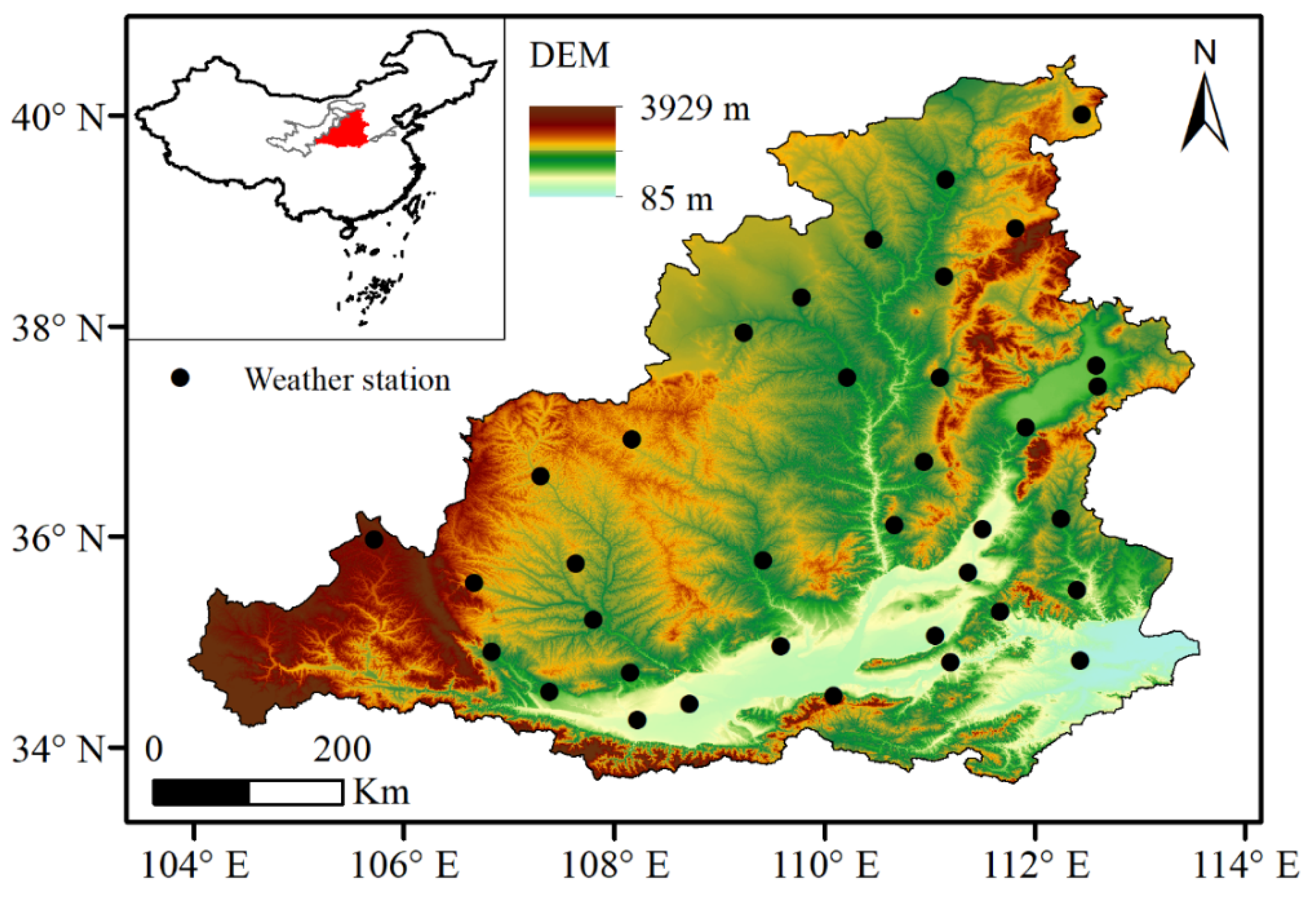
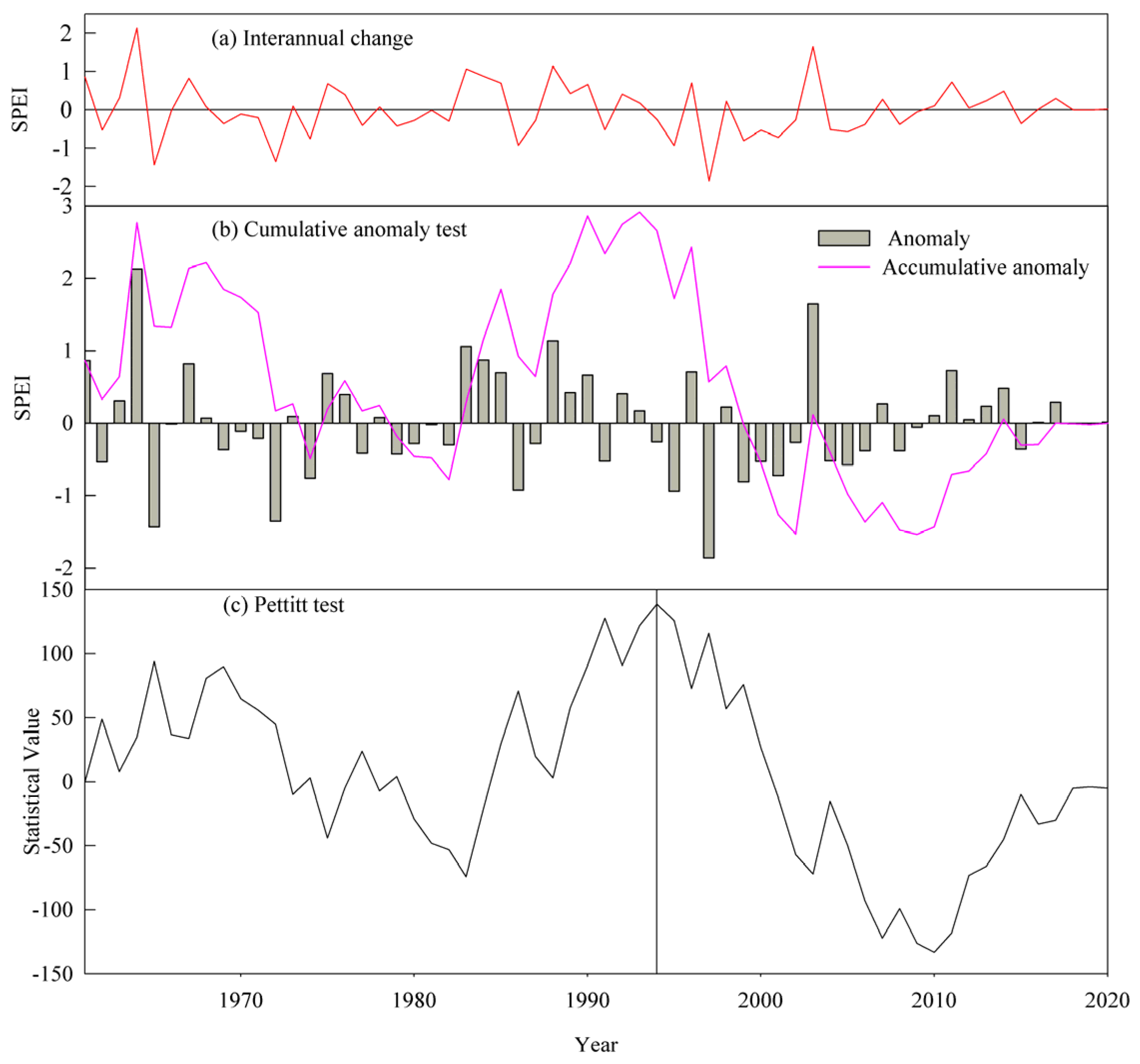
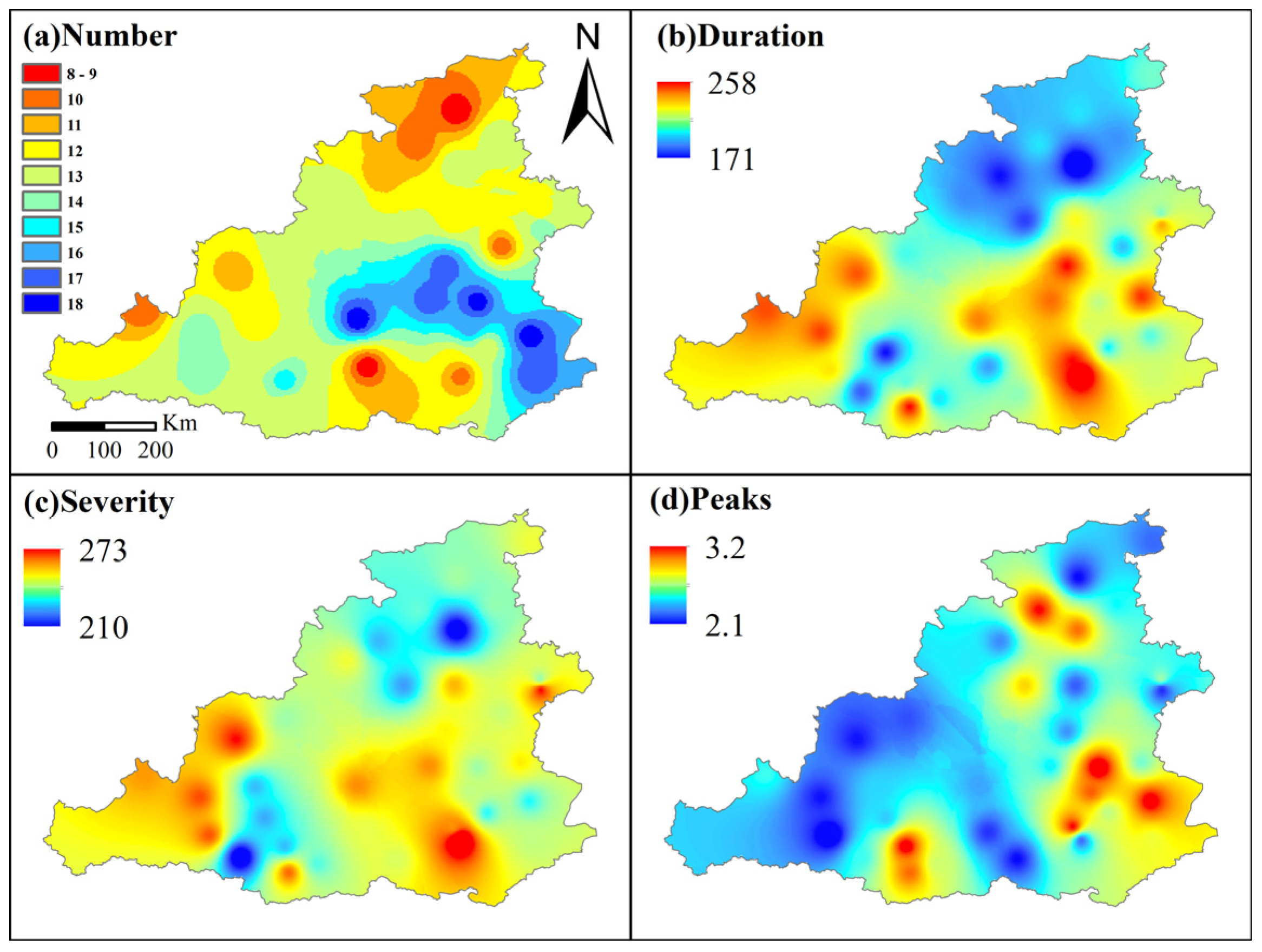

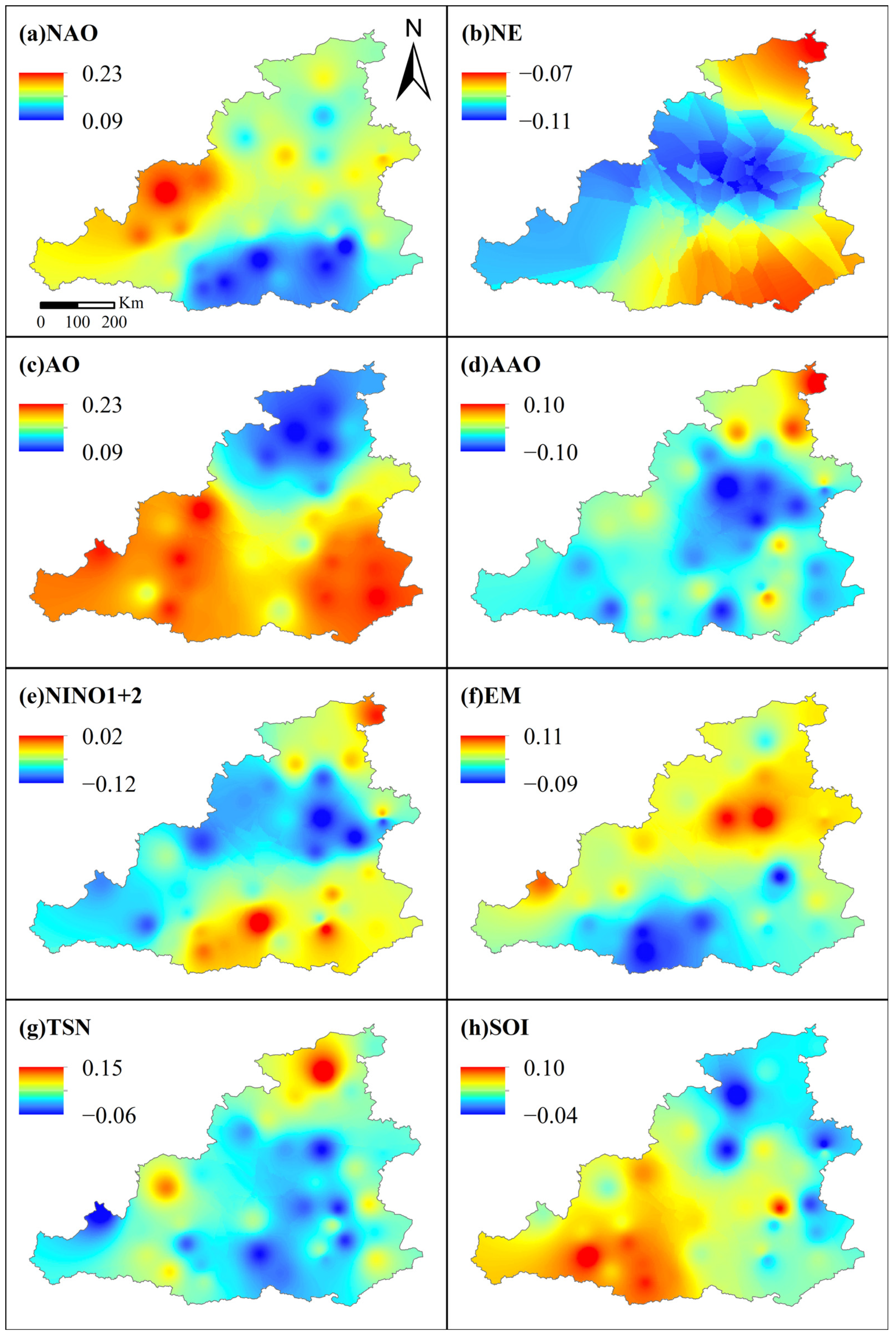


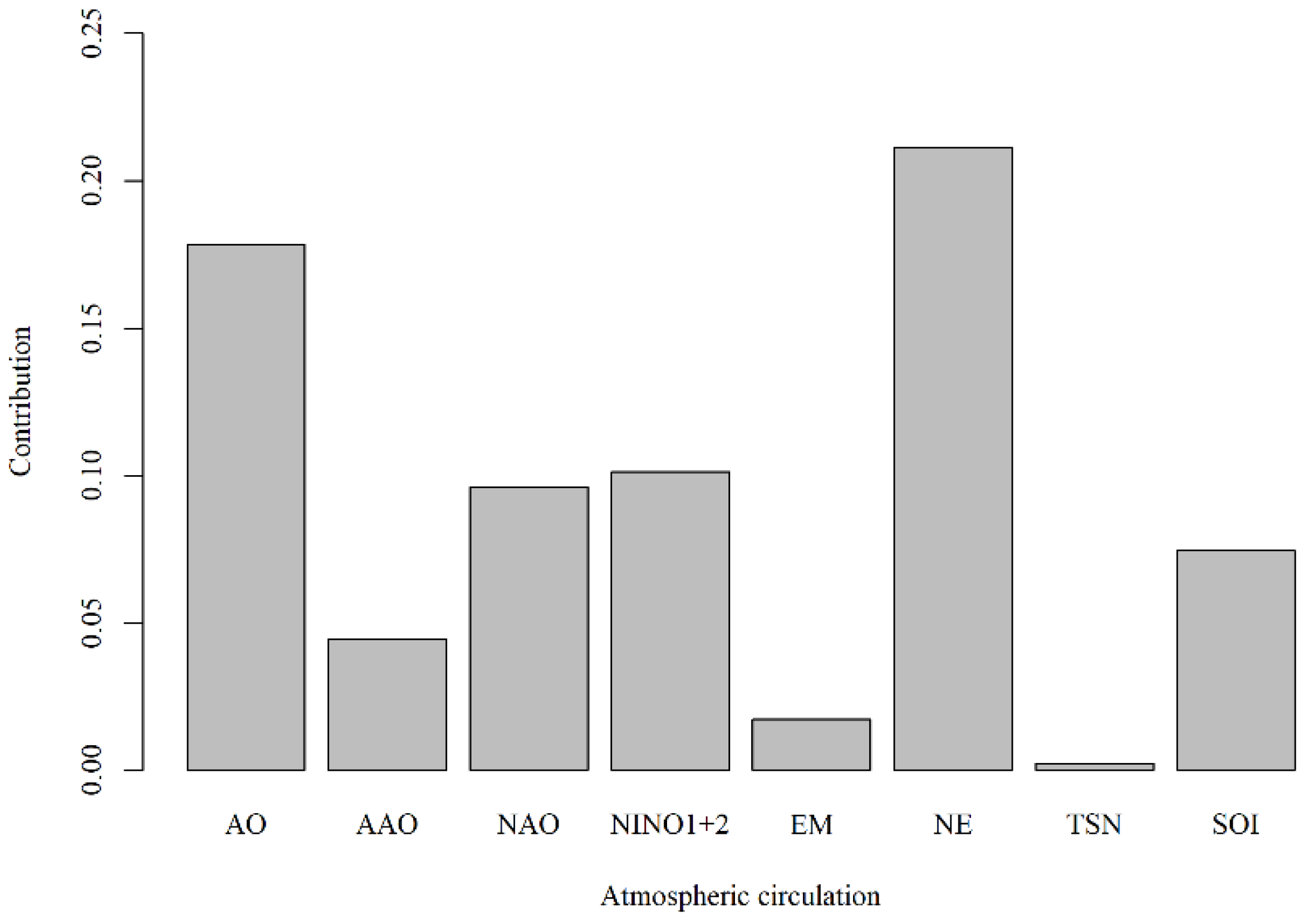
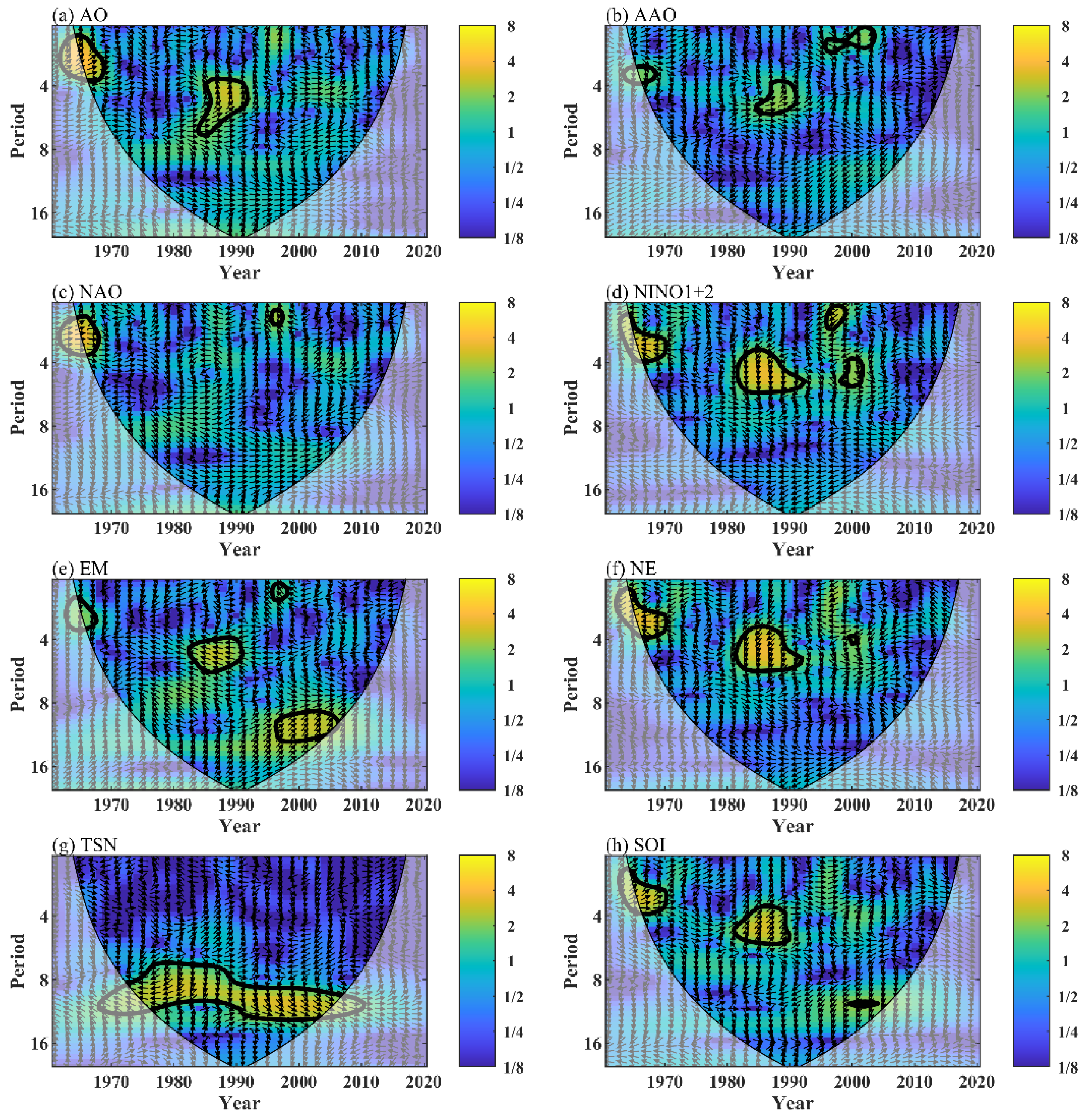

| Drought Grade | Range |
| Extreme drought | SPEI ≤ −2.0 |
| Moderate drought | −2 < SPEI ≤ −1 |
| Mild drought | −1 < SPEI ≤ −0.5 |
| No drought | SPEI > −0.5 |
| Atmospheric Circulation | Period | Interval | Relationship |
|---|---|---|---|
| AO | 1~4 | 1961~1969 | Positive |
| 3~7 | 1983~1991 | Positive | |
| AAO | 3~4 | 1963~1969 | Positive |
| 3~5 | 1984~1991 | Positive | |
| 1~3 | 1995~2003 | Positive | |
| NAO | 2~3 | 1961~1968 | Positive |
| 1~2 | 1995~1998 | Negative | |
| NINO 1+2 | 1~4 | 1963~1971 | Negative |
| 3~6 | 1981~1991 | Negative | |
| 1~2 | 1996~1999 | ||
| 4~5 | 1998~2002 | Negative | |
| EM | 2~3 | 1963~1968 | |
| 4~6 | 1982~1991 | ||
| 1~2 | 1996~1999 | Negative | |
| 10~13 | 1996~2007 | Positive | |
| NE | 1~4 | 1962~1971 | Negative |
| 3~6 | 1981~1990 | Negative | |
| TSN | 7~14 | 1968~2011 | |
| SOI | 2~4 | 1962~1970 | Positive |
| 3~5 | 1981~1990 | Positive |
Disclaimer/Publisher’s Note: The statements, opinions and data contained in all publications are solely those of the individual author(s) and contributor(s) and not of MDPI and/or the editor(s). MDPI and/or the editor(s) disclaim responsibility for any injury to people or property resulting from any ideas, methods, instructions or products referred to in the content. |
© 2024 by the authors. Licensee MDPI, Basel, Switzerland. This article is an open access article distributed under the terms and conditions of the Creative Commons Attribution (CC BY) license (https://creativecommons.org/licenses/by/4.0/).
Share and Cite
Dai, Y.; Dong, J.; Wei, Y.; Xu, M.; Javed, T.; Ayantobo, O.O.; Yao, N.; Hu, B. Investigate the Spatiotemporal Evolution of Drought and Its Interaction with Atmospheric Circulation in the Yellow River Middle Basin. Water 2024, 16, 1786. https://doi.org/10.3390/w16131786
Dai Y, Dong J, Wei Y, Xu M, Javed T, Ayantobo OO, Yao N, Hu B. Investigate the Spatiotemporal Evolution of Drought and Its Interaction with Atmospheric Circulation in the Yellow River Middle Basin. Water. 2024; 16(13):1786. https://doi.org/10.3390/w16131786
Chicago/Turabian StyleDai, Yuanxin, Jinlong Dong, Yingnan Wei, Mengyuan Xu, Tehseen Javed, Olusola Olaitan Ayantobo, Ning Yao, and Bao Hu. 2024. "Investigate the Spatiotemporal Evolution of Drought and Its Interaction with Atmospheric Circulation in the Yellow River Middle Basin" Water 16, no. 13: 1786. https://doi.org/10.3390/w16131786








